Also: How to disembark without acting clumsy
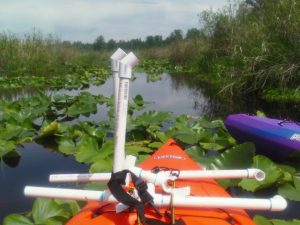
I realize it seems like a cliché to say it was a perfect day of kayaking. But then I realized that every day kayaking IS a perfect day! And so that’s how it was on Lake Cassidy today, the second Monday in May. Lake Cassidy is located in Snohomish County, east of Marysville.
Recreational areas reopened in Washington state as restrictions during the co+ vid controversy (henceforth referred to as co-con) are beginning to loosen. So first I bought our annual Discover Pass, now available again, which had previously been unavailable online because of the co-con. When you purchase it online, you’re able to print a temporary pass, and the permanent one is delivered via USPS.
Now, the big, main point of this blog post comes at the end of our outing on Lake Cassidy. So if you want to skip to the end, feel free. It has to do with the device I built of PVC, which shows up randomly and occasionally in the photos in this post. Keep reading if you want the highlights of our outing, which includes an adventure in the marshy wetlands where the lake feeds into Catherine Creek.
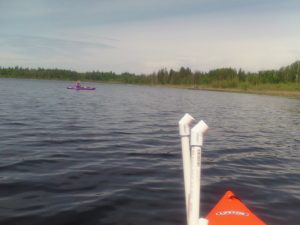
The day was sunny with high clouds. Temperature was pleasantly warm, not a scorching heat, but rather more of a radiant warmth, perhaps enhanced because I was wearing compression sleeves, primarily as a sunblock.
We saw a very blue Great Blue Heron, flying low over the lake twice. Not only him, but also the sky appears much more blue, thanks to the co-con restrictions, which, in turn, causes the lakes around here to be more blue. This heron looked quite large — huge wingspan, of course — with his legs curled up beneath him. Lake Cassidy also is home to a family of eagles. While bicycling along the Centennial Trail, we had previously identified their nest, which today was occupied by two juveniles, while their parent was searching for their meal. (In this not-too-clear photo, the eagles’ nest is visible to the right of center.)
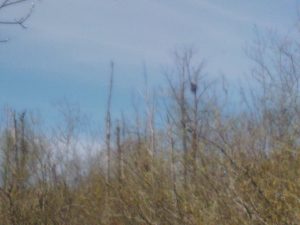
We heard the juveniles calling out to the parent. First we saw him (or her) soaring above the lake. But then, oddly, we found him prancing on the ground on the northern shore. To us, this seemed like unusual behavior. We kept our distance on the lake, to not disturb him, while I tried to capture this on video. We speculated that he had just captured his own meal, perhaps a rodent, and was consuming it. Eventually he took off and soared away to catch the next prey that he would take home to the nest, and his hungry offspring.
There are almost no houses or buildings along the northern or eastern shores because there is essentially no solid shoreline. Instead, it is very marshy with cattails, lilypads and other water plants. So mostly there are modest, older houses set far back, with long docks stretching beyond the marshland to the lake. Thus, Lake Cassidy is not overdeveloped, unlike most of the lakes around here. Two geese flew low together across the lake; the remainder of their flock was resting on a long front lawn at one of the houses. And I saw one lonely duck, while my paddling companion was investigating whether there were any frog eggs in the marsh along the shoreline.
Catherine Creek wetlands
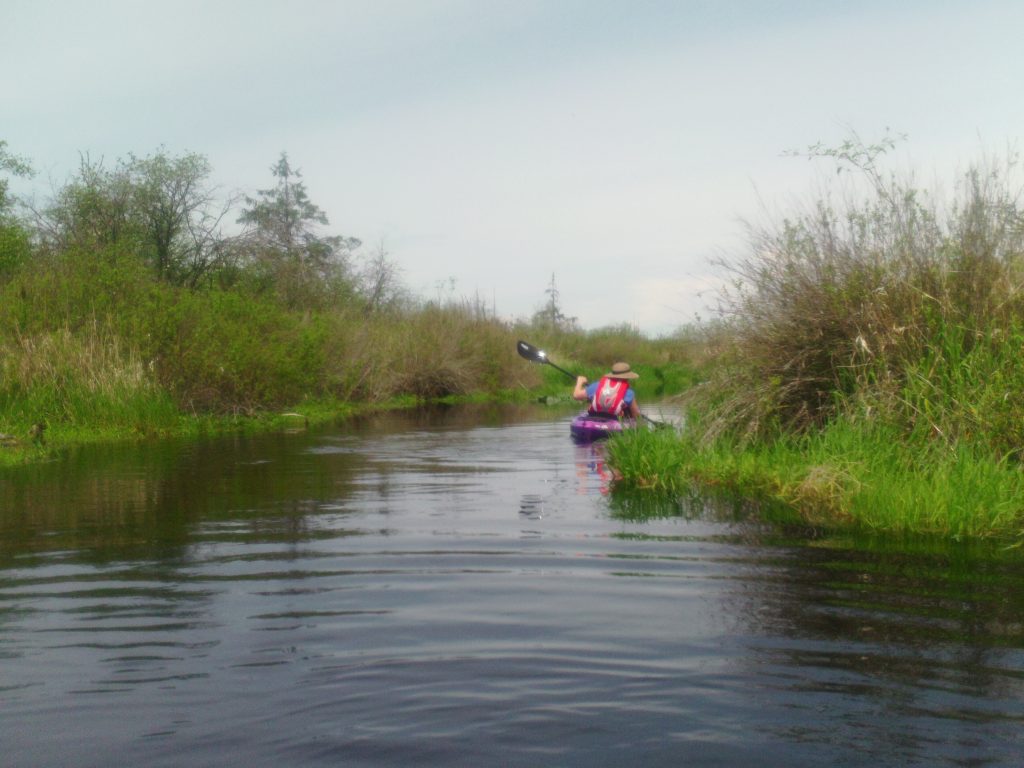
Several birdhouses are mounted on poles along the lake’s southern shore, and they appear to be occupied. Exploring this southern end of Lake Cassidy is the highlight of this outing. “Fed by Little Martha Lake, Lake Cassidy drains southward to the Pilchuck River via Catherine Creek.”* My paddling companion was ahead of me, and as I headed through the water-lillies and into the tall bulrushes and coontails, I could no longer see her. She was completely hidden. In this wetland area where Lake Cassidy converges to form Catherine Creek, narrow channels meander through the marsh. I paddled into a wider area among the tall reeds by myself, but soon decided I should find my companion. It was so much fun exploring this secluded area. We continued following the creek, noticing a slight current, until we came to a bridge crossing it. That’s when we agreed to turn around and head back into the lake. This adventure allowed us to discover perfect solitude and quietness in a tranquil zone with bird sounds and dragonflies, accessible only by kayak.
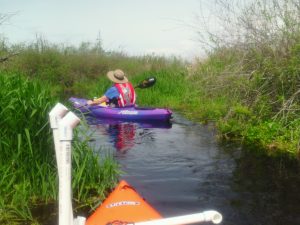
In case you were wondering, how does Lake Cassidy compare in size to one of our favorite lakes, Blackmans Lake (that’s right, no apostrophe) in Snohomish? Well, Lake Cassidy itself is roughly twice as big, and its watershed is approximately five times bigger. Here are the stats:
“Blackmans Lake is located within the City of Snohomish, just east of Hwy 9. The area of the lake is 62.9 acres with an average depth of 14 feet. The watershed, or the land area that drains into the lake, covers 510.7 acres and about 50% of that land is developed.”
“Lake Cassidy is located north of Lake Stevens and three miles east of Marysville. The lake covers 131.0 acres and has an average depth of 11 feet. The watershed, or the land area that drains into the lake, covers 2,649.6 acres and about 18% of the land is developed.”
I never realized before how shallow are some of these glacier-formed lakes.
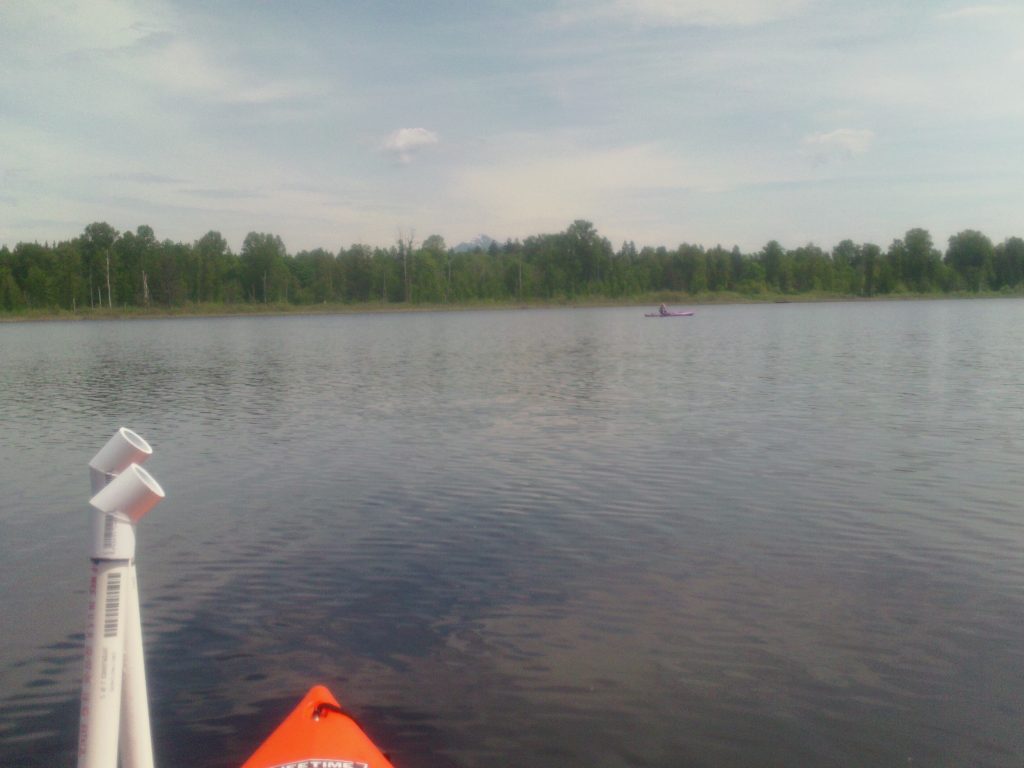
How I now disembark
And now for the most important and final event of this outing! Perhaps by this point you’re wondering how that PVC contraption works, the one you’ve noticed in the photos. As usual, I paddled hard and fast in order to beach my kayak on the gravel launch area. I laid my paddle aside, tethered to my kayak with a lanyard. Then I began to remove my new PVC device from its cargo location. Once free, I inserted it into the cabin.
The two long arms in the front, which you can see in the photos, extend inside the cabin toward the bow. Then I take the T-shaped leg and insert it into the top of this piece. By the way, that T-shaped leg is dual-purpose. I also used it to push off when launching my kayak at the beginning of the outing. Then I attach the brace between the cross-arm and the leg, forming a strong triangle structure. (The purple piece in the photos is not part of it. It’s only there to support it for the picture, which isn’t needed when it’s inside the kayak.)
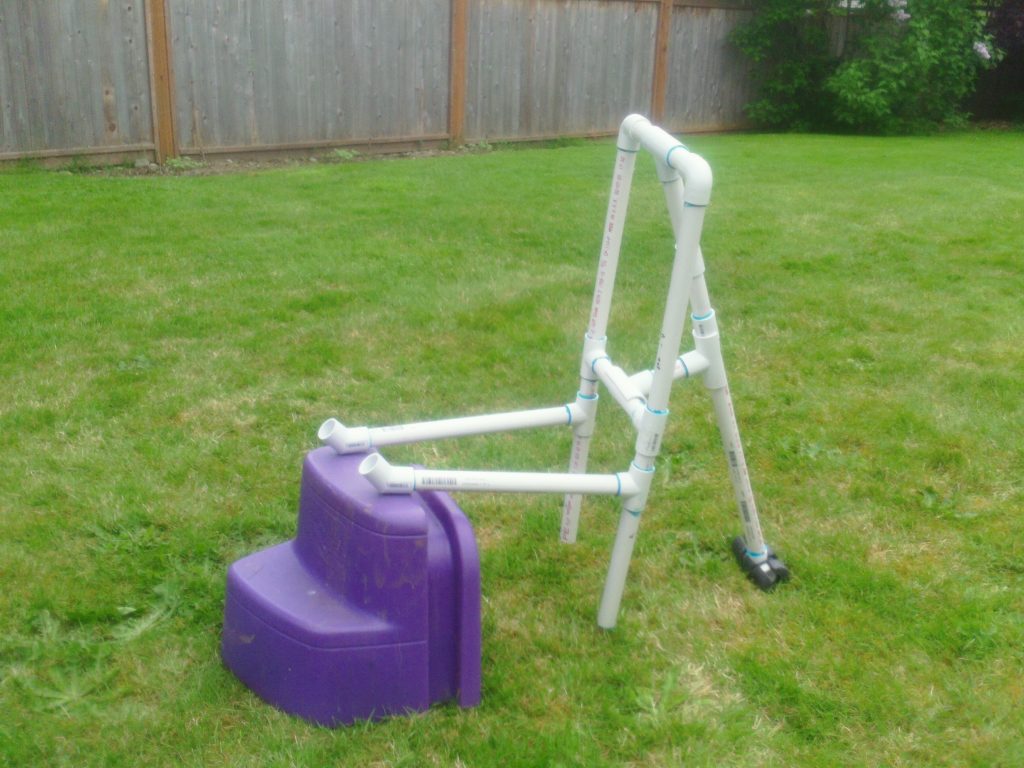
At the current age of my current body, and after my legs have been dormant for approximately two hours, I’ve discovered that disembarking from my kayak is the most difficult chore of the outing. So this PVC apparatus permits me to pull myself up, and then stand with stability. Slowly (being a Tai Chi master) while holding the device for support, I lift one foot and place it outside the kayak. Still gripping the device, I lift my other foot out, and I have successfully disembarked using my new device!
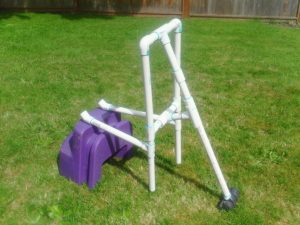
At that point, I feel super good about disembarking without being clumsy. It really worked! I was elated. So of course, my new device has a patent pending, and if somebody else tries to sell you one who claims that “one size fits all,” don’t buy it. Each style of kayak is unique, and so my device must be custom built. Of course, kayak manufacturers could make these for each of their kayak styles. Licensing agreements are available. Or, after this co-con is over and relegated to the inglorious section of our global history, I’ll come over to your house and build one for you. Feel free to contact me if you have any questions. And to all you Baby Boomers like me: have fun again!
Lee Cuesta
Footnote:
*https://snohomishcountywa.gov/DocumentCenter/View/62592/cassidy
